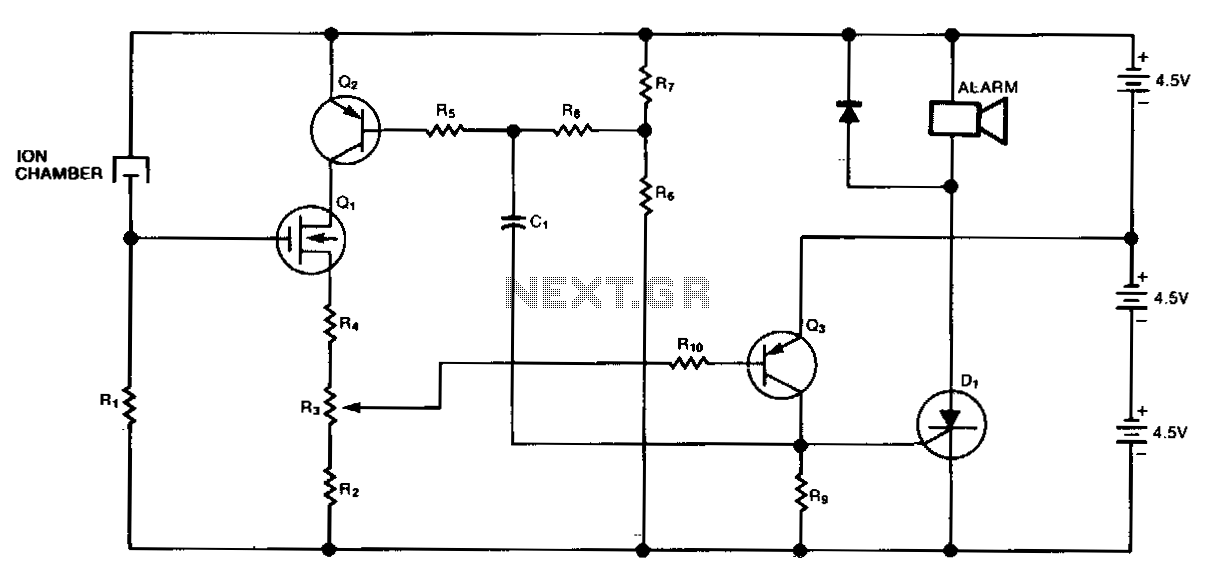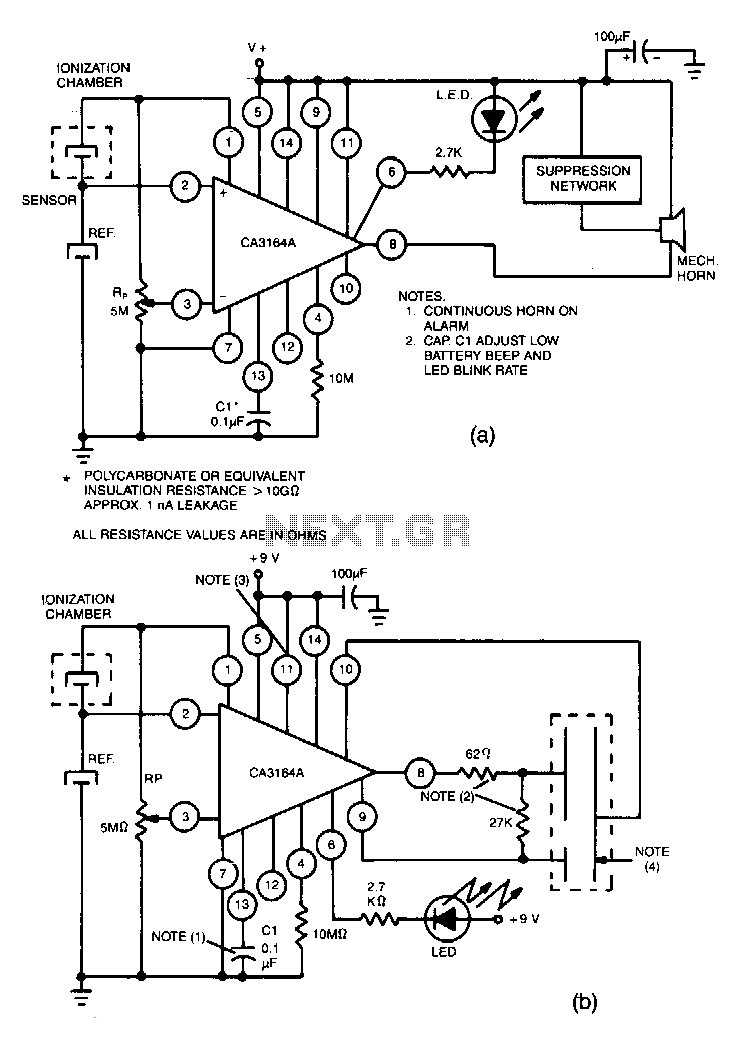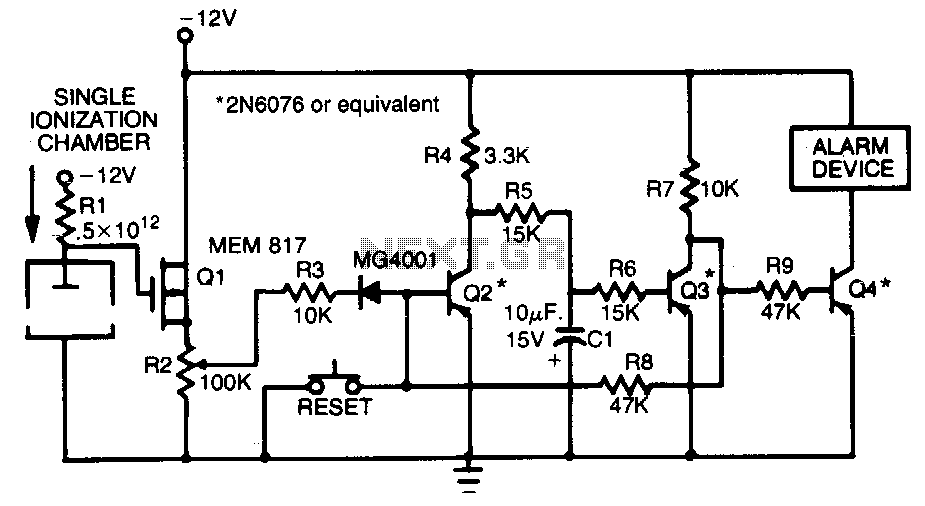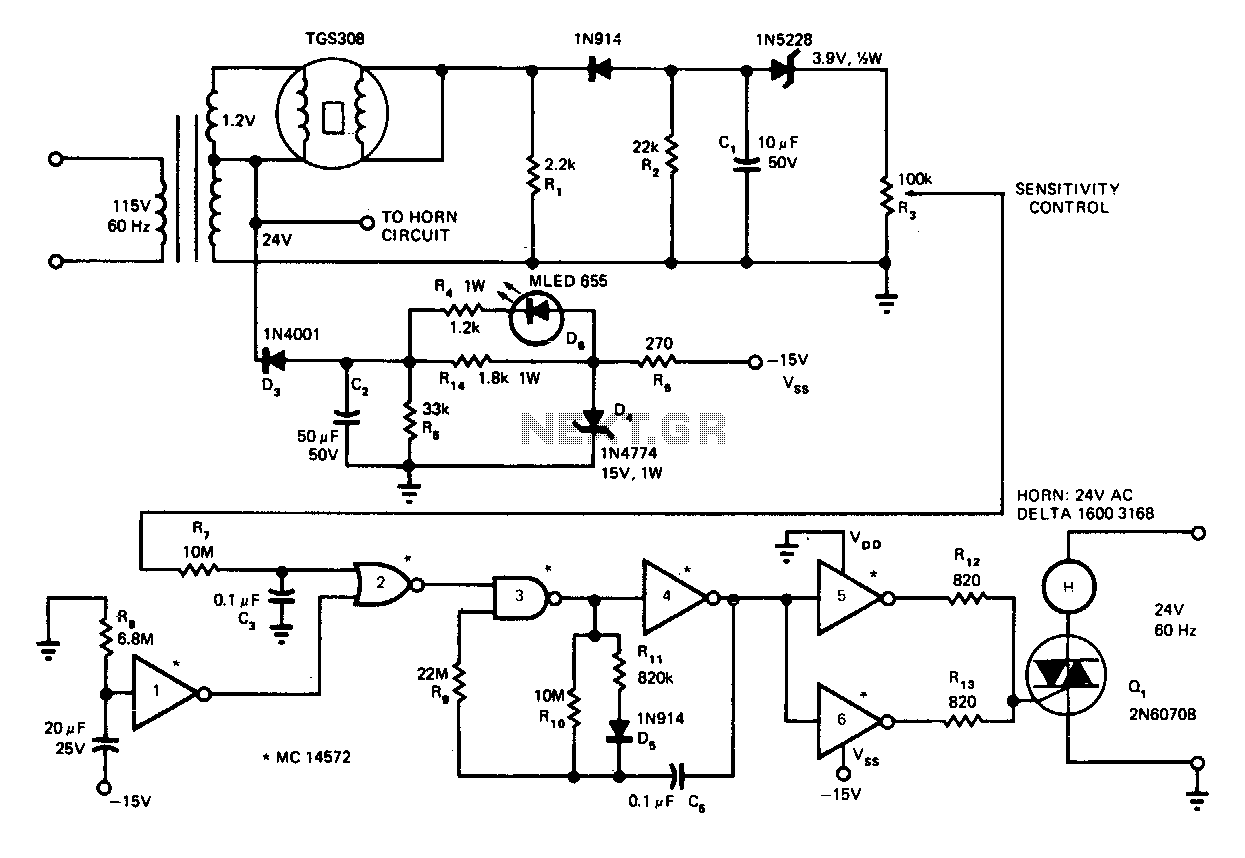
Smoke-detector

This circuit originates from U.S. Patent 3,778,800, awarded to BRK Electronics in Aurora, IL. It provides a smoke detector equipped with an alarm system for both smoke detection and low battery indication. The R6/R7 voltage divider monitors the battery voltage and will deactivate transistors Q2 and Q1 when the voltage drops below a certain threshold. Additionally, the smoke detector chamber will also deactivate Q1 upon detecting smoke. Q1, in conjunction with Q3, triggers SCR D1 to activate the alarm. Capacitor C1 offers feedback, resulting in the alarm sounding intermittently. The smoke detector and low battery circuits activate the alarm at two distinct rates.
The circuit's design incorporates a voltage divider formed by resistors R6 and R7, which plays a critical role in monitoring the battery's state. When the battery voltage is adequate, Q2 and Q1 remain in an active state, allowing the circuit to function normally. However, if the voltage drops below the designated level, the voltage divider output signals Q2 to turn off, subsequently leading to the deactivation of Q1. This feature is crucial for ensuring that the smoke detector does not operate under insufficient power conditions, which could compromise its functionality.
The smoke detection mechanism is integrated into the circuit through a dedicated chamber that senses smoke particles. When smoke is detected, this chamber generates a signal that turns off Q1, effectively silencing the alarm system until the smoke is cleared. This dual functionality ensures that the device can respond appropriately to both smoke and battery conditions, enhancing its reliability.
The triggering of SCR D1 by Q1 and Q3 is pivotal for the alarm sound generation. SCR D1 acts as a switch that allows a higher current to flow through the alarm sounder, producing an audible alarm in response to smoke detection or low battery status. The feedback provided by capacitor C1 is essential for creating an intermittent alarm sound, which serves to alert users without causing continuous disturbance. The distinct activation rates of the smoke detection and low battery alarms allow users to differentiate between the two conditions, thus facilitating appropriate responses.
In summary, this circuit exemplifies a robust design for a smoke detector that not only alerts users to the presence of smoke but also monitors battery health, ensuring reliable operation and safety.This circuit comes from U.S. Patent 3, 778,800, granted to BRK Electronics in Aurora, IL. The circuit provides a smoke detector with an alarm for both smoke and low batteries. The R6/R7 voltage divider monitors the battery and will turn Q2 and Ql off when the battery voltage falls too low. The smoke-detector chamber will also cut Ql off when it senses smoke. Ql via Q3, triggers SCR Dl and sounds the alarm. Capacitor Cl provides feedback that causes the alarm to sound intermittently. The smoke detector and low-battery circuits sound the alarm at two different rates.
The circuit's design incorporates a voltage divider formed by resistors R6 and R7, which plays a critical role in monitoring the battery's state. When the battery voltage is adequate, Q2 and Q1 remain in an active state, allowing the circuit to function normally. However, if the voltage drops below the designated level, the voltage divider output signals Q2 to turn off, subsequently leading to the deactivation of Q1. This feature is crucial for ensuring that the smoke detector does not operate under insufficient power conditions, which could compromise its functionality.
The smoke detection mechanism is integrated into the circuit through a dedicated chamber that senses smoke particles. When smoke is detected, this chamber generates a signal that turns off Q1, effectively silencing the alarm system until the smoke is cleared. This dual functionality ensures that the device can respond appropriately to both smoke and battery conditions, enhancing its reliability.
The triggering of SCR D1 by Q1 and Q3 is pivotal for the alarm sound generation. SCR D1 acts as a switch that allows a higher current to flow through the alarm sounder, producing an audible alarm in response to smoke detection or low battery status. The feedback provided by capacitor C1 is essential for creating an intermittent alarm sound, which serves to alert users without causing continuous disturbance. The distinct activation rates of the smoke detection and low battery alarms allow users to differentiate between the two conditions, thus facilitating appropriate responses.
In summary, this circuit exemplifies a robust design for a smoke detector that not only alerts users to the presence of smoke but also monitors battery health, ensuring reliable operation and safety.This circuit comes from U.S. Patent 3, 778,800, granted to BRK Electronics in Aurora, IL. The circuit provides a smoke detector with an alarm for both smoke and low batteries. The R6/R7 voltage divider monitors the battery and will turn Q2 and Ql off when the battery voltage falls too low. The smoke-detector chamber will also cut Ql off when it senses smoke. Ql via Q3, triggers SCR Dl and sounds the alarm. Capacitor Cl provides feedback that causes the alarm to sound intermittently. The smoke detector and low-battery circuits sound the alarm at two different rates.



